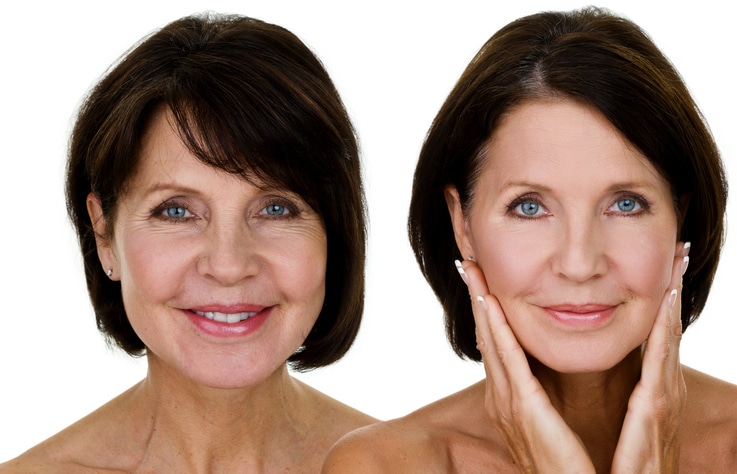In time, gravity, sun exposure, and the stresses of daily life take their toll on our faces and necks. Deep creases appear beside the mouth, the jaw line slackens and jowls develop. The neck develops loose folds and fat deposits. Facelifts counteract these signs of aging by tightening muscle, removing fat, and trimming excess skin, giving your face a fresher, youthful look. After surgery, some patients look 10-15 years younger. Facelifts, technically known as rhytidectomies (literally, “removal of wrinkles”), rejuvenate the mid- to lower face and neck.
Be sure to give us a call at 212.472.8700 to learn more about Facelift in Manhattan, NY!
When Are Facelifts Most Effective?
Facelifts are most effective for patients who want to correct:
- Midface sagging
- Deep creases under the eyes
- Deep creases between the nose and mouth (nasolabial folds)
- Jowls due to loss of muscle tone
- Sagging areas of fat
- Loose skin and fat under the chin and jaw
What Are The Drawbacks I Can Expect From A Facelift?
Facelifts can produce a dramatic improvement in appearance for patients with the problems mentioned above. However, facelifts do not stop the aging process; in time, signs of aging will gradually appear once again. Further, facelifts will not rejuvenate the brow, eyelids, nose, and some of the midface. Patients who want to improve these areas may consider combining a facelift with a brow lift or eyelid surgery (blepharoplasty).
Injectable soft-tissue fillers, facial implants and skin resurfacing can also enhance the effects of a facelift.
Am I A Candidate For A Facelift?
The best candidates for rhytidectomy:
- Wish to improve one or more of the signs of aging indicated above
- Men or women whose faces have begun to sag, but whose skin still has some elasticity
- Are generally healthy
- Do not smoke
- Have realistic expectations
- Consider a facelift for personal reasons, not because someone else is pressuring them to do so. During your consultation, your doctor will discuss whether a facelift is right for you.

What Is The Facelift Procedure?
Facelifts are typically performed in our accredited outpatient facility. Patients may have a choice of IV sedation or general anesthesia. The procedure takes about two hours. The way a facelift is performed varies depending on the patient’s facial structure and the extent of correction desired. The three most common incision techniques are:
- Traditional facelift: The “full” facelift for rejuvenating the face, jowls and neck, including fat sculpting, lifting and repositioning of muscle and deeper tissues, and skin trimming and redraping. The incision begins at the temples and travels down inside and just in front of the ear, around the earlobe, and behind the ear to the lower scalp at the hairline.
- Limited-incision or mid-facelift: For limited rejuvenation around the eyes and mouth, including nasolabial folds and other deep creases. Short incisions are made at the temples and around the ear, and possibly in the lower eyelids and/or under the upper lip as well.
- Neck lift: A neck lift concentrates on jowls, loose skin on the neck, and fat under the chin. The incision is made around the ear lobe and behind the ear to the lower scalp. In all three methods, incisions are closed with stitches. Scars are hidden in the hairline and natural contours and creases of the face.
What Is The Recovery Like After A Facelift?
After your rhytidectomy, Dr. Monasebian and his nurses will wrap the incisions in bandages and may place drainage tubes in the area. The tubes will be taken out the next day, when your hair will be carefully washed. Sutures will be removed within the first week. At first, you may experience swelling, numbness, bruising, and a feeling of tightness or tension in the face and neck. Your face may look uneven or distorted, and your facial muscles may feel stiff. Most of these usually resolve within 2-4 weeks, and sensation typically returns to normal within a few months. Scars become less red, raised, lumpy or itchy in time. Many patients return to work by the second or third week. Camouflage cosmetics can be used to minimize the appearance of bruising. Most patients are “socially” acceptable after ten days. You should be gentle with your skin and hair as you recover. Men may need to shave behind the neck and ears where areas of beard-growing skin have moved. Results of a facelift do not last forever. You may want to have another procedure in seven or ten years. But in another sense, the effects are permanent; years later, your face will continue to look better than if you had never had a facelift.
Schedule Your Facelift Consult In Manhattan Today!
Call 212.472.8700 to contact Dr. Douglas M. Monasebian and learn more about Facelifts and whether the procedure is right for you! You can also fill out the form in our contact page, and our staff will help you set up a one-on-one appointment with Dr. Monasebian. Our practice looks forward to serving you!

